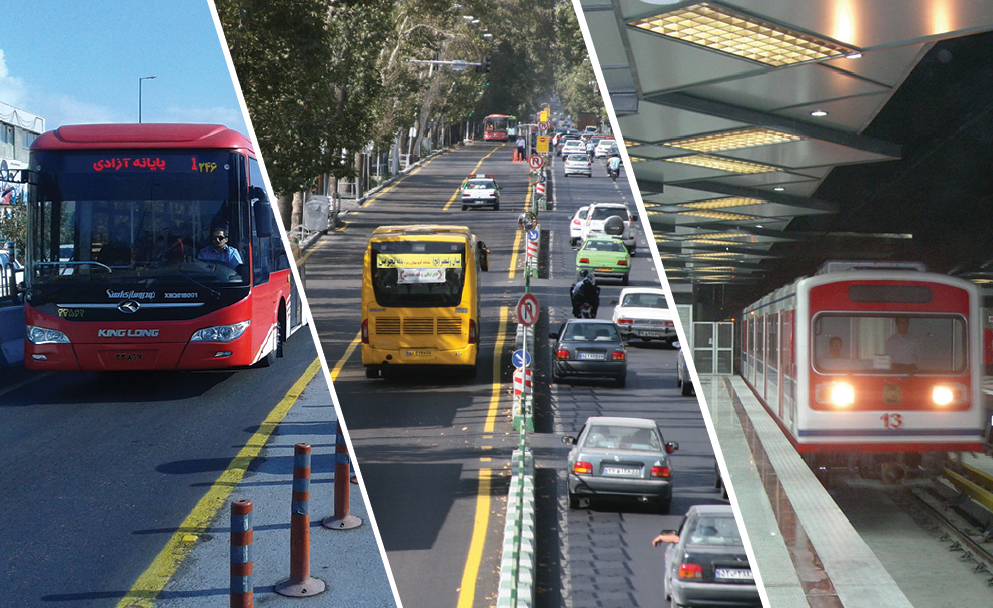Experts, people and officials have repeatedly blamed Tehran’s suffocating traffic as well as the worsening air pollution partly on the city’s inadequate, old and inefficient public transportation system.
“The only way to reduce air pollution in the capital city is to develop the urban transport network and infrastructure,” says Maziar Hosseini, deputy for transportation and traffic affairs at the Tehran Municipality.
Buses account for 23% of all transportation in the overcrowded metropolis and developing public transportation, particularly in the southern districts where it is a preferred means of commuting, is high on the agenda.
Hosseini said the city needs at least 10,000 buses for its daily commuting needs, while there are 7,000, a portion of which are “off duty” for repairs.
The TM is planning to purchase or renovate 3,000 buses, and has signed contracts with local manufacturers to buy 500 CNG-fueled buses.
“The municipality prefers locally-manufactured vehicles as long as they are of high quality.”
Expanding public transport and other essential urban infrastructure in the metropolis of 12 million is a top priority for Tehran Municipality in the next year, which starts in March, said TM’s financial deputy, Qodratollah Goudarzi, ISNA reported.
A total of 26 single-cabin buses were added to two routes in District 16 in south Tehran on Tuesday.
The buses allocated to the new routes are new since usually this area sees the worst levels of air pollution due to the high traffic density.
The city usually beefs up public transport capacity prior to the start of the new academic year in autumn. Capacity for Tehran’s public transport system was increased to accommodate 300,000 more people as the new school year began on September 21, 2016.
Another 50 buses are expected to be added by the end of the current fiscal year in March.
The capital aims to refurbish its entire fleet of public buses over the next few years by phasing out the older gas guzzlers.
Feasibility studies are underway to set up LRT lines (light rail transit) in the historical ring in the city’s downtown District 12 covering Baharestan, Jomhouri, and Grand Bazaar areas, which are host to historical textures and old buildings that attract tourists the year round.
“We are also planning to turn BRT line 7, which stretches from Rah-Ahan Square (railway station) in south Tehran to Tajrish Square in the north, into LRT,” said Hosseini.
Based on studies by the TM, this single line carries 250,000-300,000 passengers per day, and cannot meet the rising daily demand. The Tehran Bus Rapid Transit has a network of over 150 km and carries more than 3-4 million passengers daily.
According to a report from Belarus last month, the Belarusian bus builder Belkommunmash is to sell electric buses to Tehran in the new future.
Supporting Local Producers
Sixty-five new metro train coaches were added to the subway fleet in Tehran Province last Monday. The capacity of the Tehran subway network is currently 3.5-4 million passengers daily, which will increase by more than 225,000 commuters with the new coaches.
A large portion of the TM budget for next year, proposed to increase to $5.6 billion (220 trillion rials) in the government’s budget presented to parliament in December, will go toward expansion of subway lines, purchasing and renovating the bus fleet, and completing urban projects.
The government has allocated $2 billion to import 2,000 subway cars, the deputy interior minister for construction, urban and rural development said.
“The move will be in line with a bill passed by the parliament,” Houshang Khandan added, noting that the coaches will be imported in the second half of the upcoming fiscal year, IRNA reported.
Parliament has also approved a bill that requires the government to increase the share of domestic companies in the manufacture of equipment used in railroad projects, including coaches, to at least 85% by the end of the sixth five-year development plan (2016-21).
Helping the Physically Disabled
All public transport systems will be equipped with route maps in Braille with BRT lines on priority, according to Hosseini.
The designing of the route maps has been completed for BRT Line 1 and will be available soon at every bus stop along the route, he said.
Line 1 stretches from the iconic Azadi Square to Khavaran Terminal in the west of the city, passing through the main junctions and squares in the downtown areas.
Use of Braille timetables and raised letter signage for route maps are common in many developed countries.
“Just like the subways, BRT stops will also be equipped with audio systems to assist the visually-impaired at the stops.”
Under a memorandum of understanding with Tehran Urban and Suburban Railway Operation Company (Tehran Metro), a local knowledge-based company will begin studies to design and implement a project for guiding the visually and hearing impaired commuters.
Based on the agreement, feasibility studies will begin on optimizing pathways at subway stations as well as installing various assisting elements such as tactile paving to help pedestrians with visual or hearing disability.


